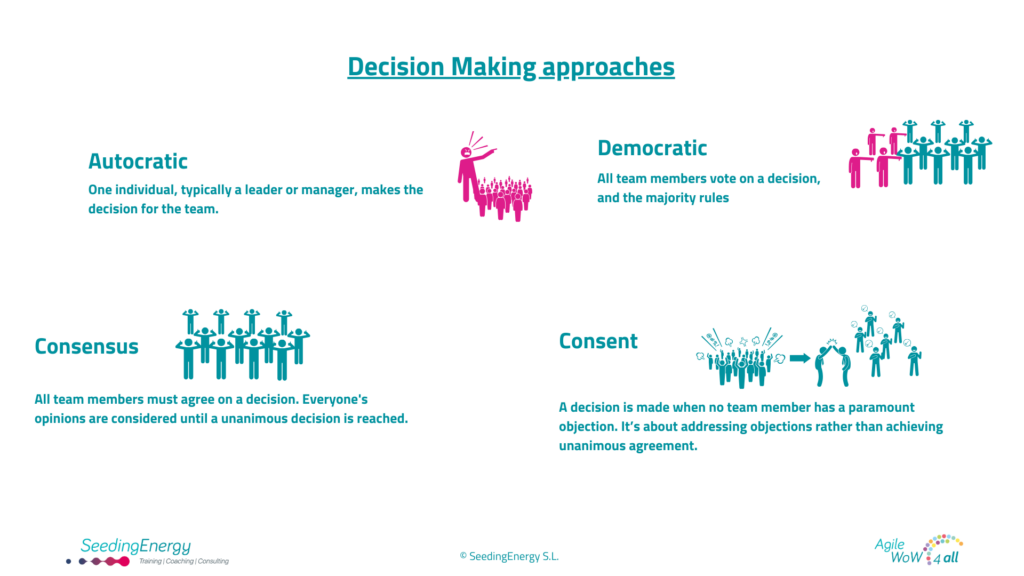

03/07/2024
Decision Making in an Agile Environment: The Power of Consent
Agile organisations or teams, characterized by their emphasis on flexibility, collaboration, and rapid iteration, present unique challenges and opportunities for decision-making. Sociocracy (S3.0), particularly the consent-based decision-making model, stands out as a robust approach among various methodologies. This article explores decision-making dynamics in agile environments, weighs the pros and cons of different methods, and makes a case for the efficacy of Sociocracy’s (S3.0) consent decision-making.
The Agile Decision-Making Landscape
In agile environments, decision-making must be swift, inclusive, and adaptable. Teams work in short cycles, often termed sprints, necessitating a decision-making process that supports rapid development and continuous improvement.
Common Decision-Making Approaches

- Autocratic Decision-Making: One individual, typically a leader or manager, makes the decision for the team.
Pros: Quick and clear directives, less time-consuming.
Cons: Can lead to low team morale, lack of buy-in, and potential for overlooked insights.
- Democratic Decision-Making: All team members vote on a decision, and the majority rules.
Pros: Inclusive, ensures broad input, fosters a sense of ownership.
Cons: Time-consuming, potential for gridlock, may not always yield the best solution due to compromise.
- Consensus Decision-Making: All team members must agree on a decision. Everyone’s opinions are considered until a unanimous decision is reached.
Pros: High level of agreement and commitment, thorough exploration of options.
Cons: Extremely time-consuming, risk of lowest-common-denominator solutions.
- Consent Decision-Making (S3.0)
A decision is made when no team member has a paramount objection. It’s about addressing objections rather than achieving unanimous agreement.
Pros: Balances speed and inclusiveness, ensures no paramount objections, fosters continuous improvement.
Cons: Requires training and a cultural shift, initial implementation can be challenging.
The Case for Sociocracy (S3.0): Consent Decision-Making
Sociocracy (S3.0), particularly its consent-based decision-making model, offers a compelling middle ground that aligns well with agile principles.
Understanding Consent Decision-Making
In consent decision-making, a proposal is adopted if no one has a paramount objection. This does not mean unanimous agreement but rather an absence of strong objections. The process typically involves:
- Proposal Formulation: A team member or a group drafts a proposal.
- Clarifying Questions: Team members ask questions to understand the proposal fully.
- Reaction Round: Members share their initial thoughts and concerns.
- Amend and Clarify: The proposal is amended based on feedback.
- Consent Round: Members express any paramount objections, which are addressed until no such objections remain.
Pros and Cons of Consent Decision-Making in Agile
1. Efficiency and Effectiveness:
- Balances the need for rapid decision-making with thorough vetting of ideas.
- Reduces the risk of stagnation and endless debates, as decisions are made when no paramount objections exist.
2. Enhanced Collaboration and Buy-In:
- Encourages active participation and input from all team members, fostering a collaborative environment.
- Increases commitment to decisions, as everyone has a chance to voice concerns and influence outcomes.
3. Continuous Improvement:
- Aligns with agile’s iterative nature by allowing decisions to be revisited and improved upon.
- Ensures that decisions are not final and can evolve as more information becomes available or circumstances change.
4. Inclusivity without Paralysis:
- Ensures that critical concerns are addressed, preventing major issues from being overlooked.
- Avoids the paralysis often associated with consensus, as the focus is on addressing objections rather than achieving unanimous agreement.
Cons of Consent Decision-Making
1. Learning Curve:
- Teams need training to understand and effectively implement the process.
- Initial stages can be slow as team members adapt to the new approach.
2. Cultural Shift:
- Requires a shift in organizational culture towards more openness and trust.
- May face resistance from those accustomed to traditional hierarchical decision-making.
In the fast-paced world of agile organisations and teams, consent decision-making in agile teams and organisations is a critical component of success. While various methods offer distinct advantages and drawbacks, the consent-based decision-making model of Sociocracy (S3.0) presents a balanced approach that aligns with the core principles of agility. By fostering inclusivity, ensuring no paramount objections, and supporting continuous improvement, consent decision-making can enhance both the speed and quality of decisions, ultimately driving better outcomes for agile teams.
Adopting Sociocracy’s (S3.0) consent decision-making in agile teams and organisations can lead to more effective and resilient teams, capable of navigating the complexities of modern projects with agility and collaboration. For organisations willing to invest in the necessary cultural shift and training, the rewards of this approach are substantial, making it a powerful tool in the agile decision-making arsenal.
We can help accompany you and your team leaders to create agile and resilient teams or organisations. If you want to learn more, please do not hesitate to contact us!
